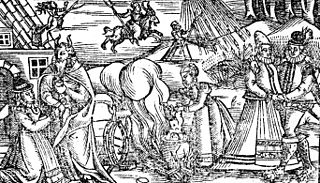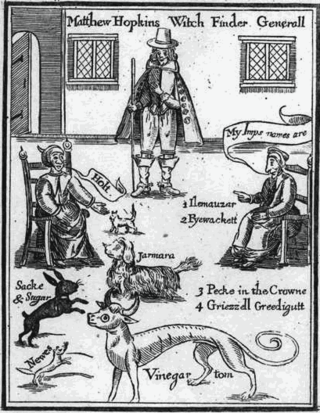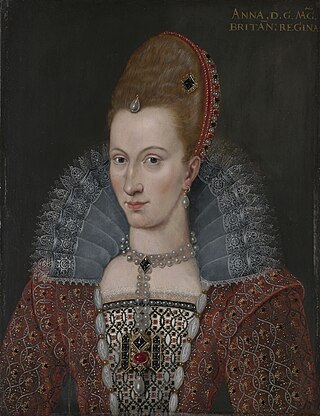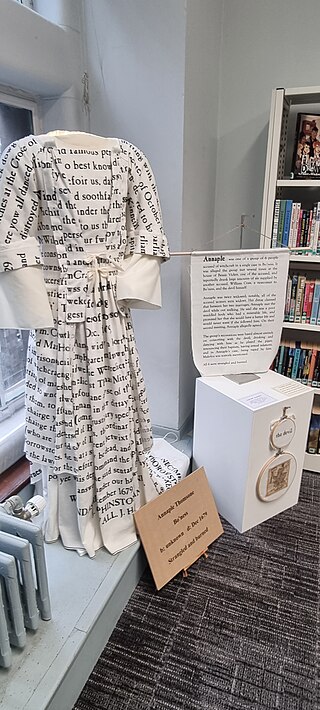
Agnes Finnie (died 6 March 1645) was an Edinburgh shopkeeper and moneylender who was executed for witchcraft on 6 March 1645.

Agnes Finnie (died 6 March 1645) was an Edinburgh shopkeeper and moneylender who was executed for witchcraft on 6 March 1645.
Agnes Finnie, widow of James Roberston, sold consumer goods, such as fish and cakes in Potterrow, Edinburgh. She had a reputation for cursing people in her neighbourhood. [1] She was charged with causing harm to several neighbours, [2] including an attack on her neighbour, James Cochrane. [3]
In June 1644, she was arrested on 20 counts of witchcraft and sorcery. She was tried on 20 December 1644 and executed on the Castle Hill of Edinburgh on Thursday, 6 March 1645. [4]
In 2008, Agnes Finnie's name was one of thousands presented for posthumous pardon to the Scottish Parliament. [5]

Agnes Finnie was one of thirteen accused witches persecuted under the Witchcraft Act of 1563, who featured in an exhibition called Witches in Word, Not Deed by Carolyn Sutton, held at the Edinburgh Central Library and toured Scotland in 2023. [6]

Isobel Gowdie was a Scottish woman who confessed to witchcraft at Auldearn near Nairn during 1662. Scant information is available about her age or life and, although she was probably executed in line with the usual practice, it is uncertain whether this was the case or if she was allowed to return to the obscurity of her former life as a cottar’s wife. Her detailed testimony, apparently achieved without the use of violent torture, provides one of the most comprehensive insights into European witchcraft folklore at the end of the era of witch-hunts.

The North Berwick witch trials were the trials in 1590 of a number of people from East Lothian, Scotland, accused of witchcraft in the St Andrew's Auld Kirk in North Berwick on Halloween night. They ran for two years, and implicated over 70 people. These included Francis Stewart, 5th Earl of Bothwell, on charges of high treason.

Agnes Sampson was a Scottish healer and purported witch. Also known as the "Wise Wife of Keith", Sampson was involved in the North Berwick witch trials in the later part of the sixteenth century.

Janet Horne was the last person to be executed legally for witchcraft in the British Isles.

In early modern Scotland, in between the early 16th century and the mid-18th century, judicial proceedings concerned with the crimes of witchcraft took place as part of a series of witch trials in Early Modern Europe. In the late middle age there were a handful of prosecutions for harm done through witchcraft, but the passing of the Witchcraft Act 1563 made witchcraft, or consulting with witches, capital crimes. The first major issue of trials under the new act were the North Berwick witch trials, beginning in 1590, in which King James VI played a major part as "victim" and investigator. He became interested in witchcraft and published a defence of witch-hunting in the Daemonologie in 1597, but he appears to have become increasingly sceptical and eventually took steps to limit prosecutions.
Geillis Duncan also spelled Gillis Duncan was a young maidservant in 16th century Scotland who was accused of being a witch. She was also the first recorded British named player of the mouth harp.

Witchcraft in Orkney possibly has its roots in the settlement of Norsemen on the archipelago from the eighth century onwards. Until the early modern period magical powers were accepted as part of the general lifestyle, but witch-hunts began on the mainland of Scotland in about 1550, and the Scottish Witchcraft Act of 1563 made witchcraft or consultation with witches a crime punishable by death. One of the first Orcadians tried and executed for witchcraft was Allison Balfour, in 1594. Balfour, her elderly husband and two young children, were subjected to severe torture for two days to elicit a confession from her.

The Pittenweem witches were five Scottish women accused of witchcraft in the small fishing village of Pittenweem in Fife on the east coast of Scotland in 1704. Another two women and a man were named as accomplices. Accusations made by a teenage boy, Patrick Morton, against a local woman, Beatrix Layng, led to the death in prison of Thomas Brown, and, in January 1705, the murder of Janet Cornfoot by a lynch mob in the village.
Beatrix Leslie was a Scottish midwife executed for witchcraft. In 1661 she was accused of causing the collapse of a coal pit through witchcraft. Little is known about her life before that, although there are reported disputes with neighbours that allude to a quarrelsome attitude.
Maud Galt was a lesbian accused of witchcraft in Kilbarchan, Scotland.
Bessie Wright was a healer in Perthshire who was accused of witchcraft in 1611, 1626 and then again in 1628.

In England, witch trials were conducted from the 15th century until the 18th century. They are estimated to have resulted in the death of perhaps 500 people, 90 percent of whom were women. The witch hunt was at its most intense stage during the English Civil War (1642–1651) and the Puritan era of the mid-17th century.
Louise Yeoman is a historian and broadcaster specialising in the Scottish witch hunts and 17th century Scottish religious beliefs.
The Witches of Bo'ness were a group of women accused of witchcraft in Bo'ness, Scotland in the late 17th century and ultimately executed for this crime. Among the more famous cases noted by historians, in 1679, Margaret Pringle, Bessie Vickar, Annaple Thomsone, and two women both called Margaret Hamilton were all accused of being witches, alongside "warlock" William Craw. The case of these six was "one of the last multiple trials to take place for witchcraft" in Scotland.

Mungo Law (c.1606–1660) was a Scottish minister of the Church of Scotland. He was minister of the Greyfriars Kirk in Edinburgh. He was a noteworthy figure in Scotland during the English Civil War.
Margaret Barclay, was an accused witch put on trial in 1618, 'gently' tortured, confessed and was strangled and burned at the stake in Irvine, Scotland. Her case was written about with horror by the romantic novelist Sir Walter Scott, and in the 21st century, a campaign for a memorial in the town and for a pardon for Barclay and other accused witches was raised in the Scottish Parliament.

Anne of Denmark (1574–1619) was the wife of King James VI and I, and as such Queen of Scotland from their marriage by proxy on 20 August 1589 and Queen of England and Ireland from 24 March 1603 until her death in 1619. When Anne intended to sail to Scotland in 1589 her ship was delayed by adverse weather. Contemporary superstition blamed the delays to her voyage and other misfortunes on "contrary winds" summoned by witchcraft. There were witchcraft trials in Denmark and in Scotland. The King's kinsman, Francis Stewart, 5th Earl of Bothwell came into suspicion. The Chancellor of Scotland John Maitland of Thirlestane, thought to be Bothwell's enemy, was lampooned in a poem Rob Stene's Dream, and Anne of Denmark made Maitland her enemy. Historians continue to investigate these events.
Katherine Campbell was a maidservant accused of theft and witchcraft during the last major witch hunt in Scotland, the Paisley witch trials.

Beatrix Watsone was accused of witchcraft in 1649 at Corstorphine Parish Church, Edinburgh, and died of suicide before trial.

Annaple Thomsone, also known as Annabel Thomson and Annaple Thomson, was accused and tried for being a witch in Bo'ness, Scotland. She was part of a group known as the Witches of Bo'ness. She was subsequently strangled with wire and burnt for witchcraft in December 1679.
Agnes Finnie.
Agnes Finnie.